Organizational Behavior Report: Roll-Royce, Culture, Power, and Teams
VerifiedAdded on 2023/01/13
|14
|4147
|84
Report
AI Summary
This report analyzes the organizational behavior of Rolls-Royce Motor Cars Limited, a luxury automobile manufacturer. It delves into the impact of organizational culture, power, and politics on employee and team behavior, utilizing Handy's model to assess different cultural types. The report explores motivational theories and techniques, including Alderfer's ERG theory and Vroom's expectancy theory, to understand how to motivate and retain employees. It also compares effective and ineffective teams, highlighting key characteristics. Finally, the report examines various concepts and philosophies of organizational behavior, offering insights into how Rolls-Royce can optimize its management practices and foster a productive work environment. The report emphasizes the importance of aligning organizational culture with motivational strategies and team dynamics to enhance overall performance and achieve business objectives.
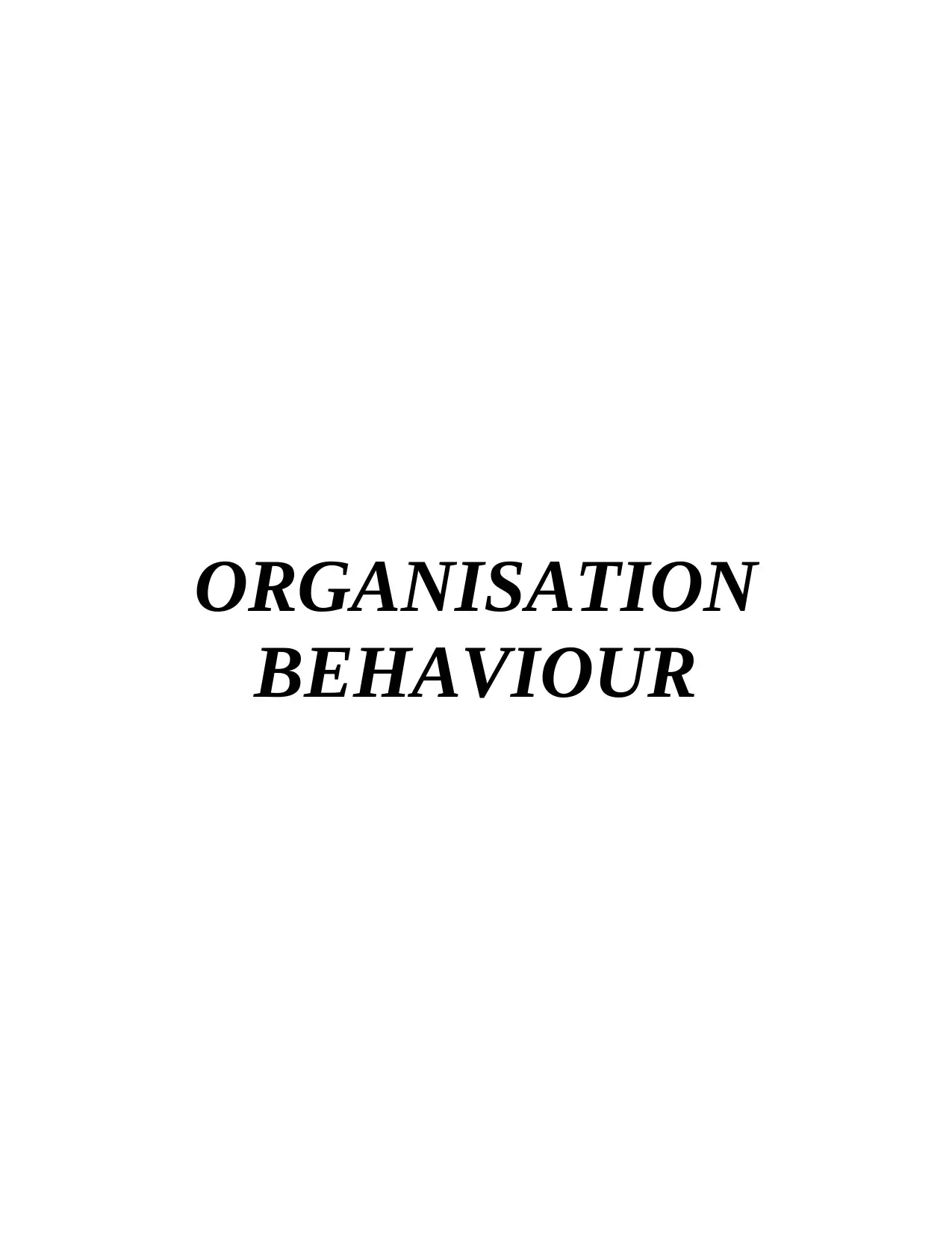
ORGANISATION
BEHAVIOUR
BEHAVIOUR
Paraphrase This Document
Need a fresh take? Get an instant paraphrase of this document with our AI Paraphraser
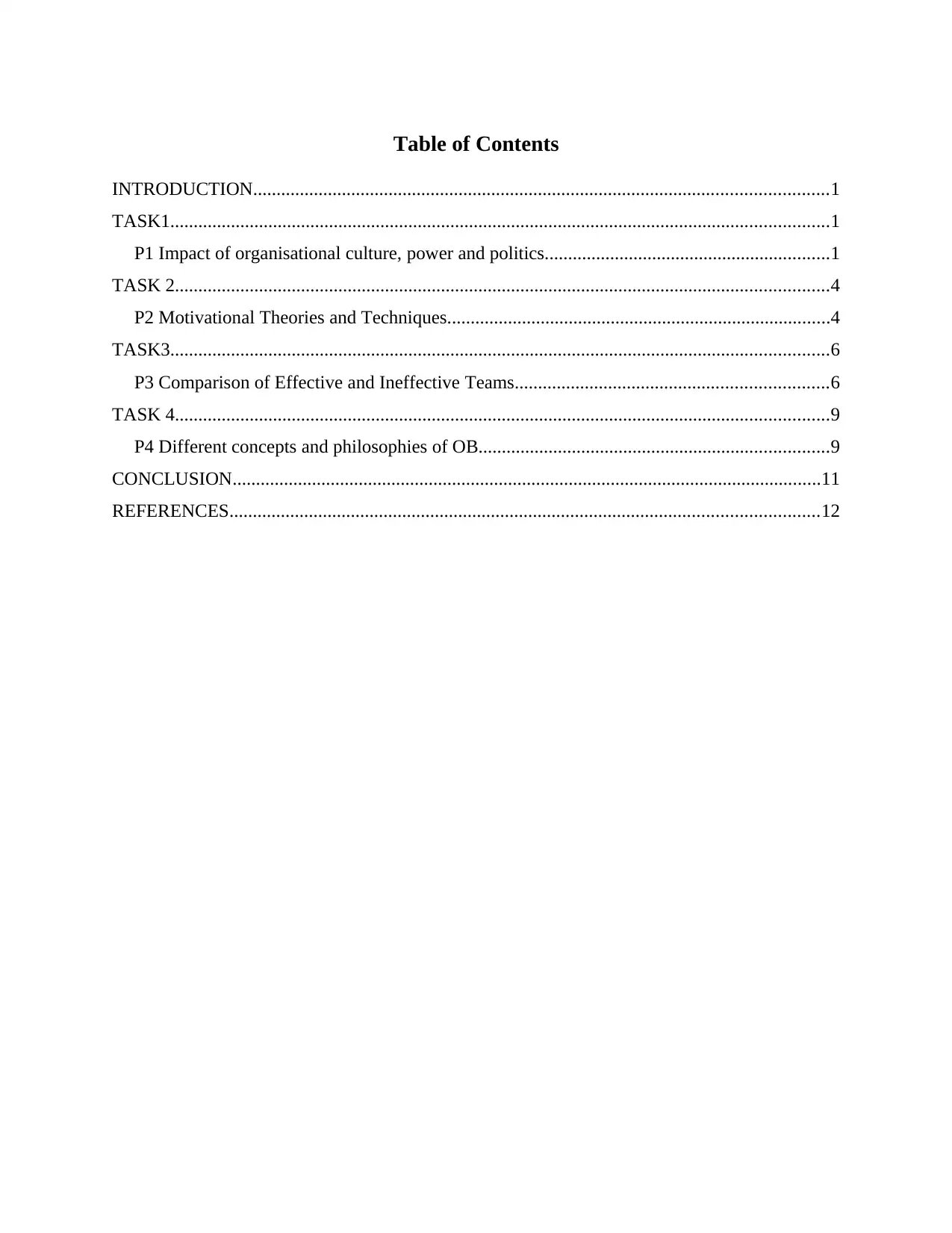
Table of Contents
INTRODUCTION...........................................................................................................................1
TASK1.............................................................................................................................................1
P1 Impact of organisational culture, power and politics.............................................................1
TASK 2............................................................................................................................................4
P2 Motivational Theories and Techniques..................................................................................4
TASK3.............................................................................................................................................6
P3 Comparison of Effective and Ineffective Teams...................................................................6
TASK 4............................................................................................................................................9
P4 Different concepts and philosophies of OB...........................................................................9
CONCLUSION..............................................................................................................................11
REFERENCES..............................................................................................................................12
INTRODUCTION...........................................................................................................................1
TASK1.............................................................................................................................................1
P1 Impact of organisational culture, power and politics.............................................................1
TASK 2............................................................................................................................................4
P2 Motivational Theories and Techniques..................................................................................4
TASK3.............................................................................................................................................6
P3 Comparison of Effective and Ineffective Teams...................................................................6
TASK 4............................................................................................................................................9
P4 Different concepts and philosophies of OB...........................................................................9
CONCLUSION..............................................................................................................................11
REFERENCES..............................................................................................................................12
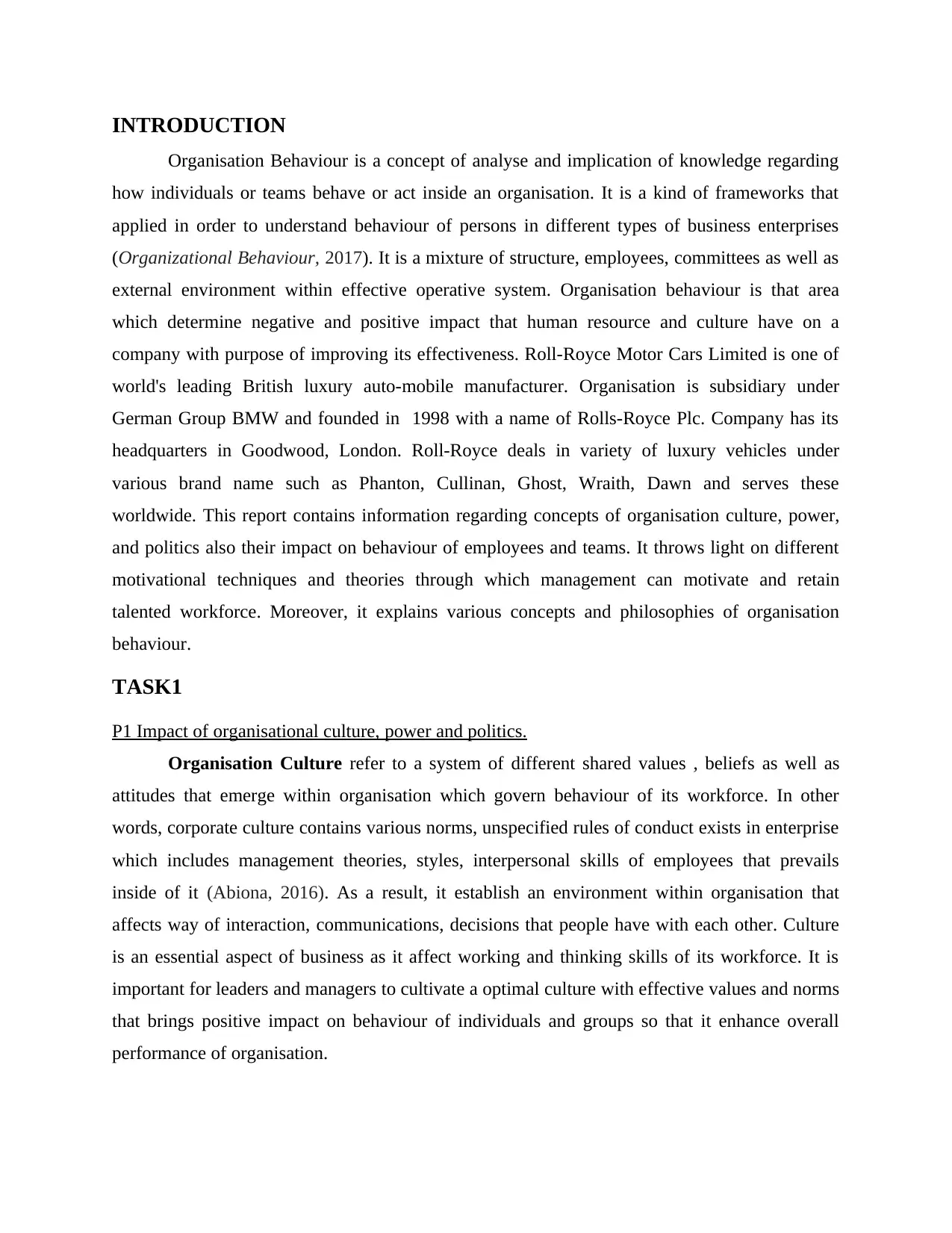
INTRODUCTION
Organisation Behaviour is a concept of analyse and implication of knowledge regarding
how individuals or teams behave or act inside an organisation. It is a kind of frameworks that
applied in order to understand behaviour of persons in different types of business enterprises
(Organizational Behaviour, 2017). It is a mixture of structure, employees, committees as well as
external environment within effective operative system. Organisation behaviour is that area
which determine negative and positive impact that human resource and culture have on a
company with purpose of improving its effectiveness. Roll-Royce Motor Cars Limited is one of
world's leading British luxury auto-mobile manufacturer. Organisation is subsidiary under
German Group BMW and founded in 1998 with a name of Rolls-Royce Plc. Company has its
headquarters in Goodwood, London. Roll-Royce deals in variety of luxury vehicles under
various brand name such as Phanton, Cullinan, Ghost, Wraith, Dawn and serves these
worldwide. This report contains information regarding concepts of organisation culture, power,
and politics also their impact on behaviour of employees and teams. It throws light on different
motivational techniques and theories through which management can motivate and retain
talented workforce. Moreover, it explains various concepts and philosophies of organisation
behaviour.
TASK1
P1 Impact of organisational culture, power and politics.
Organisation Culture refer to a system of different shared values , beliefs as well as
attitudes that emerge within organisation which govern behaviour of its workforce. In other
words, corporate culture contains various norms, unspecified rules of conduct exists in enterprise
which includes management theories, styles, interpersonal skills of employees that prevails
inside of it (Abiona, 2016). As a result, it establish an environment within organisation that
affects way of interaction, communications, decisions that people have with each other. Culture
is an essential aspect of business as it affect working and thinking skills of its workforce. It is
important for leaders and managers to cultivate a optimal culture with effective values and norms
that brings positive impact on behaviour of individuals and groups so that it enhance overall
performance of organisation.
Organisation Behaviour is a concept of analyse and implication of knowledge regarding
how individuals or teams behave or act inside an organisation. It is a kind of frameworks that
applied in order to understand behaviour of persons in different types of business enterprises
(Organizational Behaviour, 2017). It is a mixture of structure, employees, committees as well as
external environment within effective operative system. Organisation behaviour is that area
which determine negative and positive impact that human resource and culture have on a
company with purpose of improving its effectiveness. Roll-Royce Motor Cars Limited is one of
world's leading British luxury auto-mobile manufacturer. Organisation is subsidiary under
German Group BMW and founded in 1998 with a name of Rolls-Royce Plc. Company has its
headquarters in Goodwood, London. Roll-Royce deals in variety of luxury vehicles under
various brand name such as Phanton, Cullinan, Ghost, Wraith, Dawn and serves these
worldwide. This report contains information regarding concepts of organisation culture, power,
and politics also their impact on behaviour of employees and teams. It throws light on different
motivational techniques and theories through which management can motivate and retain
talented workforce. Moreover, it explains various concepts and philosophies of organisation
behaviour.
TASK1
P1 Impact of organisational culture, power and politics.
Organisation Culture refer to a system of different shared values , beliefs as well as
attitudes that emerge within organisation which govern behaviour of its workforce. In other
words, corporate culture contains various norms, unspecified rules of conduct exists in enterprise
which includes management theories, styles, interpersonal skills of employees that prevails
inside of it (Abiona, 2016). As a result, it establish an environment within organisation that
affects way of interaction, communications, decisions that people have with each other. Culture
is an essential aspect of business as it affect working and thinking skills of its workforce. It is
important for leaders and managers to cultivate a optimal culture with effective values and norms
that brings positive impact on behaviour of individuals and groups so that it enhance overall
performance of organisation.
⊘ This is a preview!⊘
Do you want full access?
Subscribe today to unlock all pages.

Trusted by 1+ million students worldwide
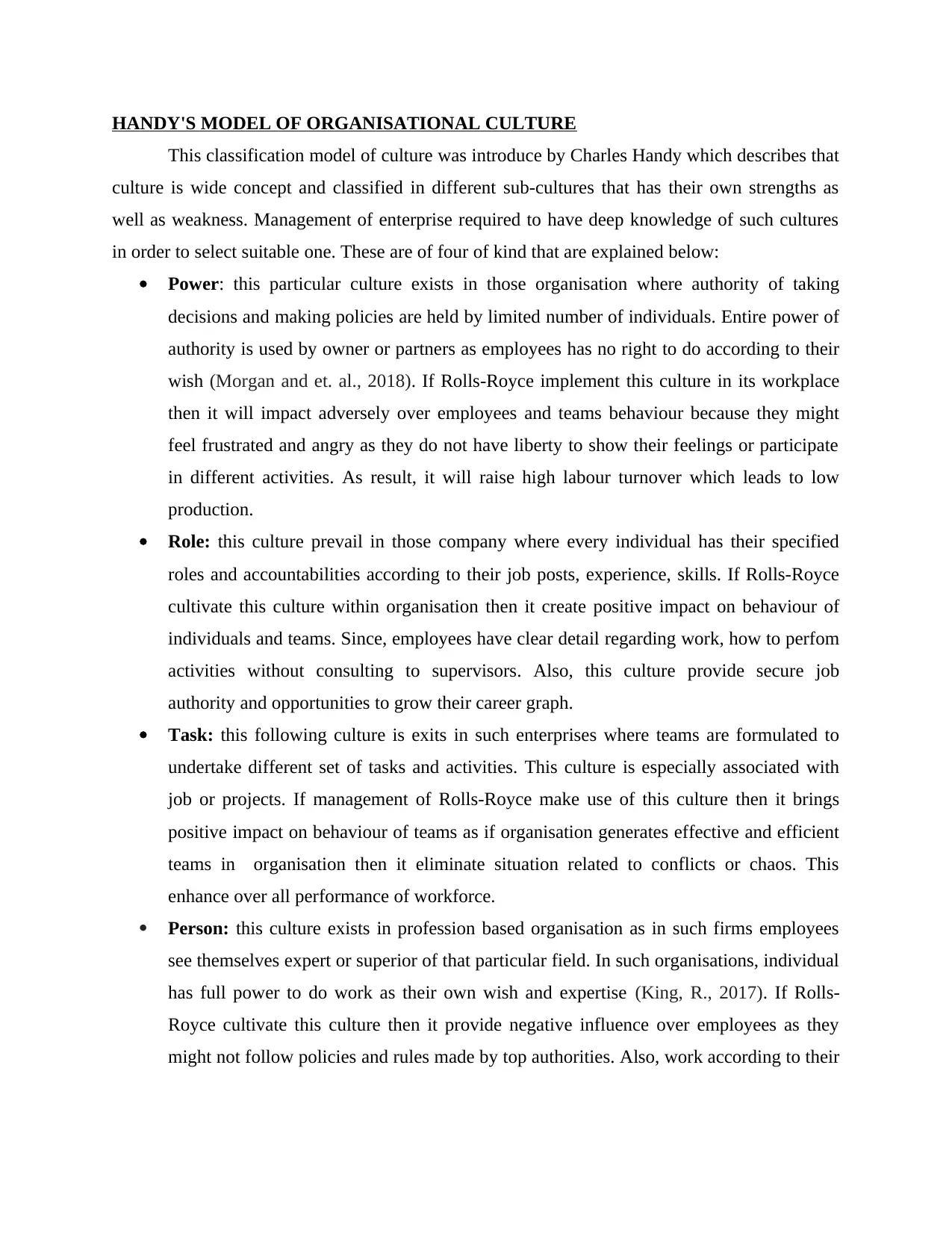
HANDY'S MODEL OF ORGANISATIONAL CULTURE
This classification model of culture was introduce by Charles Handy which describes that
culture is wide concept and classified in different sub-cultures that has their own strengths as
well as weakness. Management of enterprise required to have deep knowledge of such cultures
in order to select suitable one. These are of four of kind that are explained below:
Power: this particular culture exists in those organisation where authority of taking
decisions and making policies are held by limited number of individuals. Entire power of
authority is used by owner or partners as employees has no right to do according to their
wish (Morgan and et. al., 2018). If Rolls-Royce implement this culture in its workplace
then it will impact adversely over employees and teams behaviour because they might
feel frustrated and angry as they do not have liberty to show their feelings or participate
in different activities. As result, it will raise high labour turnover which leads to low
production.
Role: this culture prevail in those company where every individual has their specified
roles and accountabilities according to their job posts, experience, skills. If Rolls-Royce
cultivate this culture within organisation then it create positive impact on behaviour of
individuals and teams. Since, employees have clear detail regarding work, how to perfom
activities without consulting to supervisors. Also, this culture provide secure job
authority and opportunities to grow their career graph.
Task: this following culture is exits in such enterprises where teams are formulated to
undertake different set of tasks and activities. This culture is especially associated with
job or projects. If management of Rolls-Royce make use of this culture then it brings
positive impact on behaviour of teams as if organisation generates effective and efficient
teams in organisation then it eliminate situation related to conflicts or chaos. This
enhance over all performance of workforce.
Person: this culture exists in profession based organisation as in such firms employees
see themselves expert or superior of that particular field. In such organisations, individual
has full power to do work as their own wish and expertise (King, R., 2017). If Rolls-
Royce cultivate this culture then it provide negative influence over employees as they
might not follow policies and rules made by top authorities. Also, work according to their
This classification model of culture was introduce by Charles Handy which describes that
culture is wide concept and classified in different sub-cultures that has their own strengths as
well as weakness. Management of enterprise required to have deep knowledge of such cultures
in order to select suitable one. These are of four of kind that are explained below:
Power: this particular culture exists in those organisation where authority of taking
decisions and making policies are held by limited number of individuals. Entire power of
authority is used by owner or partners as employees has no right to do according to their
wish (Morgan and et. al., 2018). If Rolls-Royce implement this culture in its workplace
then it will impact adversely over employees and teams behaviour because they might
feel frustrated and angry as they do not have liberty to show their feelings or participate
in different activities. As result, it will raise high labour turnover which leads to low
production.
Role: this culture prevail in those company where every individual has their specified
roles and accountabilities according to their job posts, experience, skills. If Rolls-Royce
cultivate this culture within organisation then it create positive impact on behaviour of
individuals and teams. Since, employees have clear detail regarding work, how to perfom
activities without consulting to supervisors. Also, this culture provide secure job
authority and opportunities to grow their career graph.
Task: this following culture is exits in such enterprises where teams are formulated to
undertake different set of tasks and activities. This culture is especially associated with
job or projects. If management of Rolls-Royce make use of this culture then it brings
positive impact on behaviour of teams as if organisation generates effective and efficient
teams in organisation then it eliminate situation related to conflicts or chaos. This
enhance over all performance of workforce.
Person: this culture exists in profession based organisation as in such firms employees
see themselves expert or superior of that particular field. In such organisations, individual
has full power to do work as their own wish and expertise (King, R., 2017). If Rolls-
Royce cultivate this culture then it provide negative influence over employees as they
might not follow policies and rules made by top authorities. Also, work according to their
Paraphrase This Document
Need a fresh take? Get an instant paraphrase of this document with our AI Paraphraser
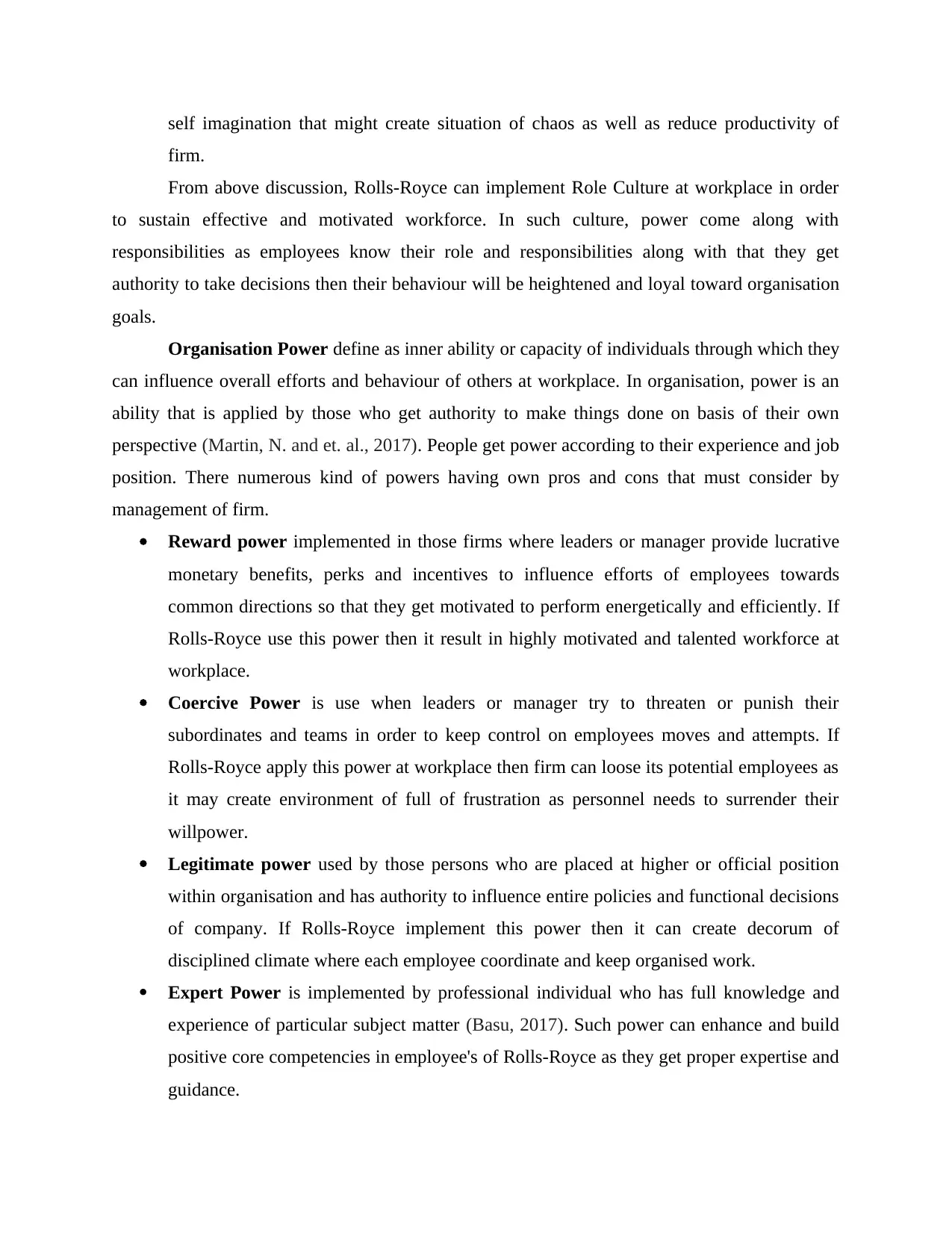
self imagination that might create situation of chaos as well as reduce productivity of
firm.
From above discussion, Rolls-Royce can implement Role Culture at workplace in order
to sustain effective and motivated workforce. In such culture, power come along with
responsibilities as employees know their role and responsibilities along with that they get
authority to take decisions then their behaviour will be heightened and loyal toward organisation
goals.
Organisation Power define as inner ability or capacity of individuals through which they
can influence overall efforts and behaviour of others at workplace. In organisation, power is an
ability that is applied by those who get authority to make things done on basis of their own
perspective (Martin, N. and et. al., 2017). People get power according to their experience and job
position. There numerous kind of powers having own pros and cons that must consider by
management of firm.
Reward power implemented in those firms where leaders or manager provide lucrative
monetary benefits, perks and incentives to influence efforts of employees towards
common directions so that they get motivated to perform energetically and efficiently. If
Rolls-Royce use this power then it result in highly motivated and talented workforce at
workplace.
Coercive Power is use when leaders or manager try to threaten or punish their
subordinates and teams in order to keep control on employees moves and attempts. If
Rolls-Royce apply this power at workplace then firm can loose its potential employees as
it may create environment of full of frustration as personnel needs to surrender their
willpower.
Legitimate power used by those persons who are placed at higher or official position
within organisation and has authority to influence entire policies and functional decisions
of company. If Rolls-Royce implement this power then it can create decorum of
disciplined climate where each employee coordinate and keep organised work.
Expert Power is implemented by professional individual who has full knowledge and
experience of particular subject matter (Basu, 2017). Such power can enhance and build
positive core competencies in employee's of Rolls-Royce as they get proper expertise and
guidance.
firm.
From above discussion, Rolls-Royce can implement Role Culture at workplace in order
to sustain effective and motivated workforce. In such culture, power come along with
responsibilities as employees know their role and responsibilities along with that they get
authority to take decisions then their behaviour will be heightened and loyal toward organisation
goals.
Organisation Power define as inner ability or capacity of individuals through which they
can influence overall efforts and behaviour of others at workplace. In organisation, power is an
ability that is applied by those who get authority to make things done on basis of their own
perspective (Martin, N. and et. al., 2017). People get power according to their experience and job
position. There numerous kind of powers having own pros and cons that must consider by
management of firm.
Reward power implemented in those firms where leaders or manager provide lucrative
monetary benefits, perks and incentives to influence efforts of employees towards
common directions so that they get motivated to perform energetically and efficiently. If
Rolls-Royce use this power then it result in highly motivated and talented workforce at
workplace.
Coercive Power is use when leaders or manager try to threaten or punish their
subordinates and teams in order to keep control on employees moves and attempts. If
Rolls-Royce apply this power at workplace then firm can loose its potential employees as
it may create environment of full of frustration as personnel needs to surrender their
willpower.
Legitimate power used by those persons who are placed at higher or official position
within organisation and has authority to influence entire policies and functional decisions
of company. If Rolls-Royce implement this power then it can create decorum of
disciplined climate where each employee coordinate and keep organised work.
Expert Power is implemented by professional individual who has full knowledge and
experience of particular subject matter (Basu, 2017). Such power can enhance and build
positive core competencies in employee's of Rolls-Royce as they get proper expertise and
guidance.
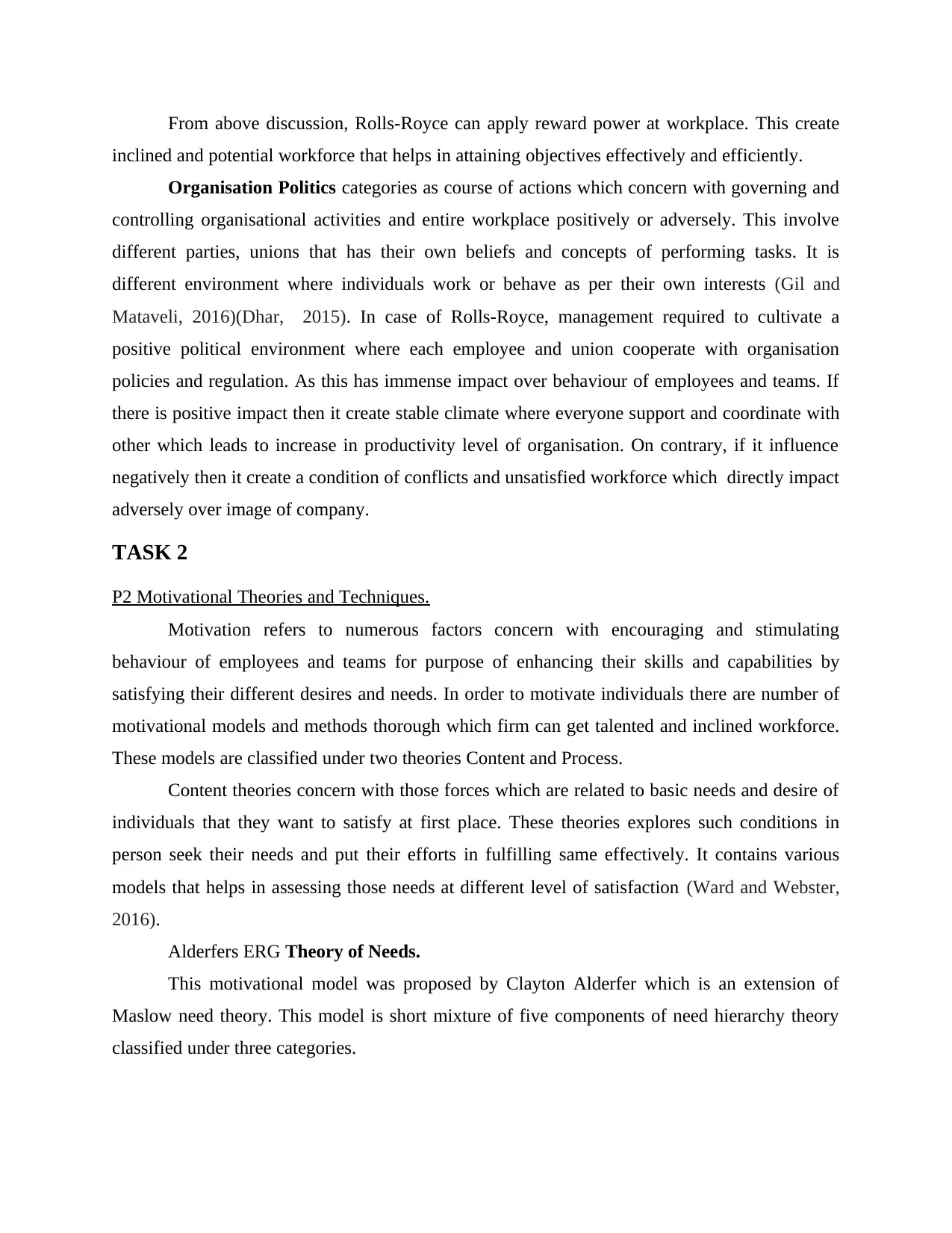
From above discussion, Rolls-Royce can apply reward power at workplace. This create
inclined and potential workforce that helps in attaining objectives effectively and efficiently.
Organisation Politics categories as course of actions which concern with governing and
controlling organisational activities and entire workplace positively or adversely. This involve
different parties, unions that has their own beliefs and concepts of performing tasks. It is
different environment where individuals work or behave as per their own interests (Gil and
Mataveli, 2016)(Dhar, 2015). In case of Rolls-Royce, management required to cultivate a
positive political environment where each employee and union cooperate with organisation
policies and regulation. As this has immense impact over behaviour of employees and teams. If
there is positive impact then it create stable climate where everyone support and coordinate with
other which leads to increase in productivity level of organisation. On contrary, if it influence
negatively then it create a condition of conflicts and unsatisfied workforce which directly impact
adversely over image of company.
TASK 2
P2 Motivational Theories and Techniques.
Motivation refers to numerous factors concern with encouraging and stimulating
behaviour of employees and teams for purpose of enhancing their skills and capabilities by
satisfying their different desires and needs. In order to motivate individuals there are number of
motivational models and methods thorough which firm can get talented and inclined workforce.
These models are classified under two theories Content and Process.
Content theories concern with those forces which are related to basic needs and desire of
individuals that they want to satisfy at first place. These theories explores such conditions in
person seek their needs and put their efforts in fulfilling same effectively. It contains various
models that helps in assessing those needs at different level of satisfaction (Ward and Webster,
2016).
Alderfers ERG Theory of Needs.
This motivational model was proposed by Clayton Alderfer which is an extension of
Maslow need theory. This model is short mixture of five components of need hierarchy theory
classified under three categories.
inclined and potential workforce that helps in attaining objectives effectively and efficiently.
Organisation Politics categories as course of actions which concern with governing and
controlling organisational activities and entire workplace positively or adversely. This involve
different parties, unions that has their own beliefs and concepts of performing tasks. It is
different environment where individuals work or behave as per their own interests (Gil and
Mataveli, 2016)(Dhar, 2015). In case of Rolls-Royce, management required to cultivate a
positive political environment where each employee and union cooperate with organisation
policies and regulation. As this has immense impact over behaviour of employees and teams. If
there is positive impact then it create stable climate where everyone support and coordinate with
other which leads to increase in productivity level of organisation. On contrary, if it influence
negatively then it create a condition of conflicts and unsatisfied workforce which directly impact
adversely over image of company.
TASK 2
P2 Motivational Theories and Techniques.
Motivation refers to numerous factors concern with encouraging and stimulating
behaviour of employees and teams for purpose of enhancing their skills and capabilities by
satisfying their different desires and needs. In order to motivate individuals there are number of
motivational models and methods thorough which firm can get talented and inclined workforce.
These models are classified under two theories Content and Process.
Content theories concern with those forces which are related to basic needs and desire of
individuals that they want to satisfy at first place. These theories explores such conditions in
person seek their needs and put their efforts in fulfilling same effectively. It contains various
models that helps in assessing those needs at different level of satisfaction (Ward and Webster,
2016).
Alderfers ERG Theory of Needs.
This motivational model was proposed by Clayton Alderfer which is an extension of
Maslow need theory. This model is short mixture of five components of need hierarchy theory
classified under three categories.
⊘ This is a preview!⊘
Do you want full access?
Subscribe today to unlock all pages.

Trusted by 1+ million students worldwide
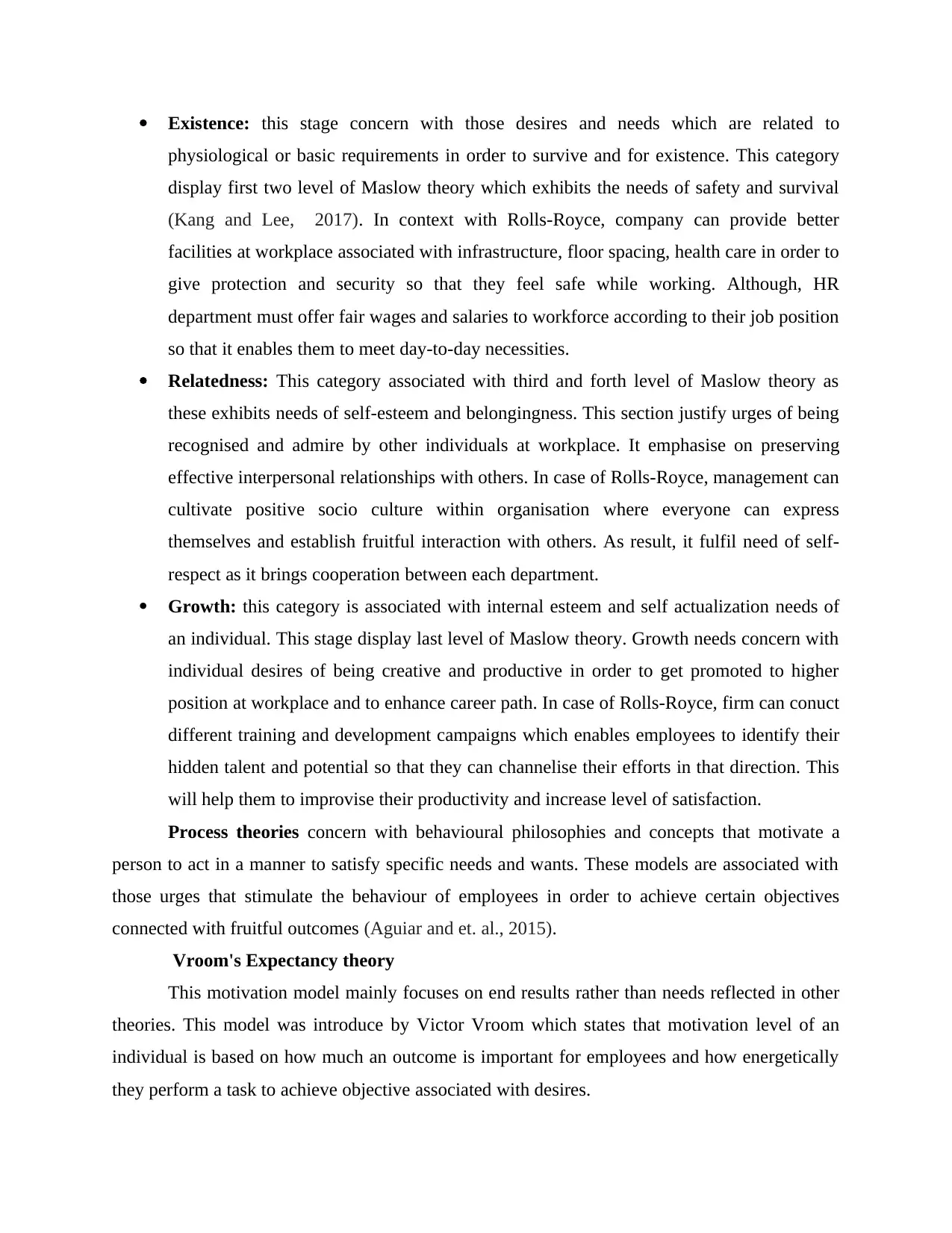
Existence: this stage concern with those desires and needs which are related to
physiological or basic requirements in order to survive and for existence. This category
display first two level of Maslow theory which exhibits the needs of safety and survival
(Kang and Lee, 2017). In context with Rolls-Royce, company can provide better
facilities at workplace associated with infrastructure, floor spacing, health care in order to
give protection and security so that they feel safe while working. Although, HR
department must offer fair wages and salaries to workforce according to their job position
so that it enables them to meet day-to-day necessities.
Relatedness: This category associated with third and forth level of Maslow theory as
these exhibits needs of self-esteem and belongingness. This section justify urges of being
recognised and admire by other individuals at workplace. It emphasise on preserving
effective interpersonal relationships with others. In case of Rolls-Royce, management can
cultivate positive socio culture within organisation where everyone can express
themselves and establish fruitful interaction with others. As result, it fulfil need of self-
respect as it brings cooperation between each department.
Growth: this category is associated with internal esteem and self actualization needs of
an individual. This stage display last level of Maslow theory. Growth needs concern with
individual desires of being creative and productive in order to get promoted to higher
position at workplace and to enhance career path. In case of Rolls-Royce, firm can conuct
different training and development campaigns which enables employees to identify their
hidden talent and potential so that they can channelise their efforts in that direction. This
will help them to improvise their productivity and increase level of satisfaction.
Process theories concern with behavioural philosophies and concepts that motivate a
person to act in a manner to satisfy specific needs and wants. These models are associated with
those urges that stimulate the behaviour of employees in order to achieve certain objectives
connected with fruitful outcomes (Aguiar and et. al., 2015).
Vroom's Expectancy theory
This motivation model mainly focuses on end results rather than needs reflected in other
theories. This model was introduce by Victor Vroom which states that motivation level of an
individual is based on how much an outcome is important for employees and how energetically
they perform a task to achieve objective associated with desires.
physiological or basic requirements in order to survive and for existence. This category
display first two level of Maslow theory which exhibits the needs of safety and survival
(Kang and Lee, 2017). In context with Rolls-Royce, company can provide better
facilities at workplace associated with infrastructure, floor spacing, health care in order to
give protection and security so that they feel safe while working. Although, HR
department must offer fair wages and salaries to workforce according to their job position
so that it enables them to meet day-to-day necessities.
Relatedness: This category associated with third and forth level of Maslow theory as
these exhibits needs of self-esteem and belongingness. This section justify urges of being
recognised and admire by other individuals at workplace. It emphasise on preserving
effective interpersonal relationships with others. In case of Rolls-Royce, management can
cultivate positive socio culture within organisation where everyone can express
themselves and establish fruitful interaction with others. As result, it fulfil need of self-
respect as it brings cooperation between each department.
Growth: this category is associated with internal esteem and self actualization needs of
an individual. This stage display last level of Maslow theory. Growth needs concern with
individual desires of being creative and productive in order to get promoted to higher
position at workplace and to enhance career path. In case of Rolls-Royce, firm can conuct
different training and development campaigns which enables employees to identify their
hidden talent and potential so that they can channelise their efforts in that direction. This
will help them to improvise their productivity and increase level of satisfaction.
Process theories concern with behavioural philosophies and concepts that motivate a
person to act in a manner to satisfy specific needs and wants. These models are associated with
those urges that stimulate the behaviour of employees in order to achieve certain objectives
connected with fruitful outcomes (Aguiar and et. al., 2015).
Vroom's Expectancy theory
This motivation model mainly focuses on end results rather than needs reflected in other
theories. This model was introduce by Victor Vroom which states that motivation level of an
individual is based on how much an outcome is important for employees and how energetically
they perform a task to achieve objective associated with desires.
Paraphrase This Document
Need a fresh take? Get an instant paraphrase of this document with our AI Paraphraser
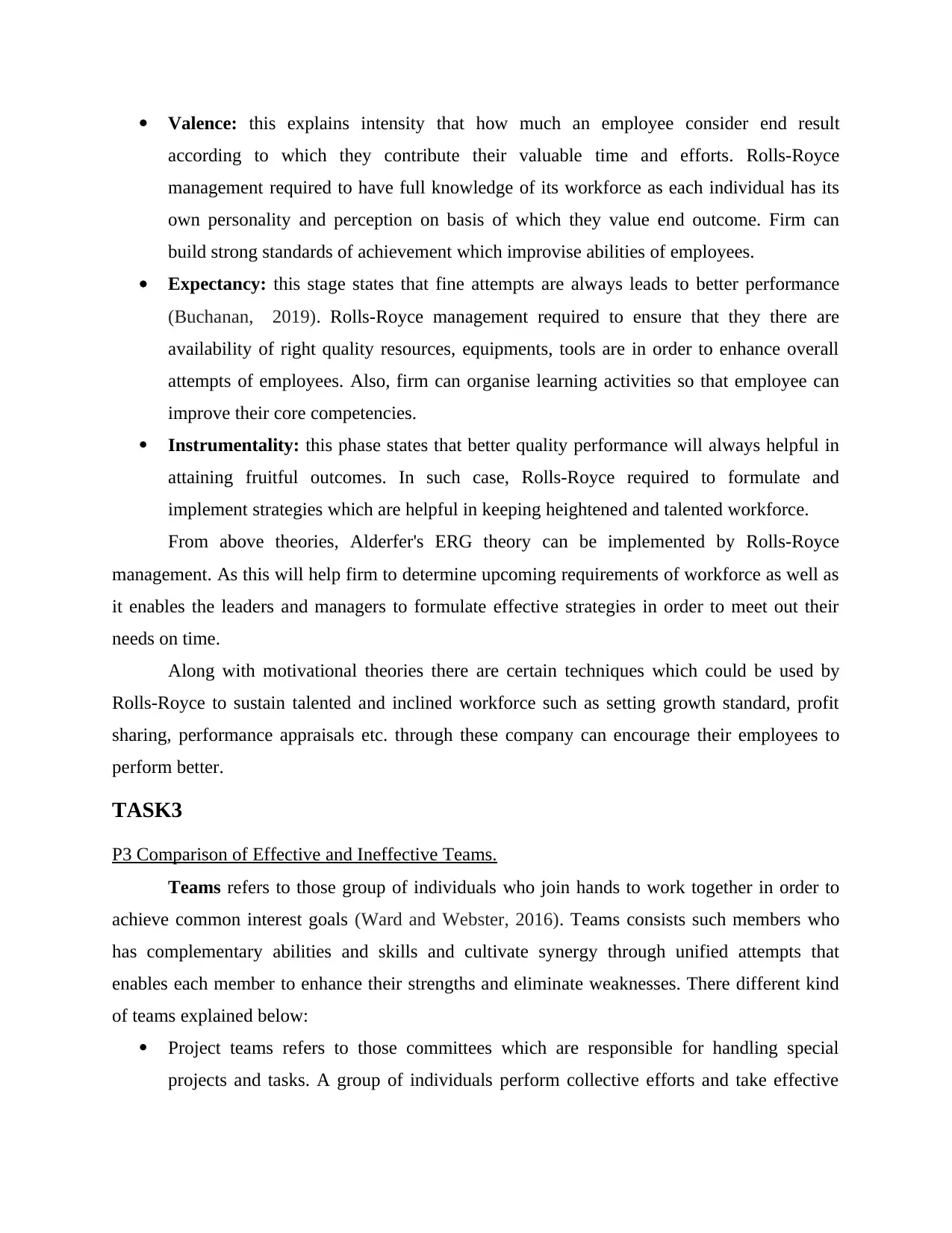
Valence: this explains intensity that how much an employee consider end result
according to which they contribute their valuable time and efforts. Rolls-Royce
management required to have full knowledge of its workforce as each individual has its
own personality and perception on basis of which they value end outcome. Firm can
build strong standards of achievement which improvise abilities of employees.
Expectancy: this stage states that fine attempts are always leads to better performance
(Buchanan, 2019). Rolls-Royce management required to ensure that they there are
availability of right quality resources, equipments, tools are in order to enhance overall
attempts of employees. Also, firm can organise learning activities so that employee can
improve their core competencies.
Instrumentality: this phase states that better quality performance will always helpful in
attaining fruitful outcomes. In such case, Rolls-Royce required to formulate and
implement strategies which are helpful in keeping heightened and talented workforce.
From above theories, Alderfer's ERG theory can be implemented by Rolls-Royce
management. As this will help firm to determine upcoming requirements of workforce as well as
it enables the leaders and managers to formulate effective strategies in order to meet out their
needs on time.
Along with motivational theories there are certain techniques which could be used by
Rolls-Royce to sustain talented and inclined workforce such as setting growth standard, profit
sharing, performance appraisals etc. through these company can encourage their employees to
perform better.
TASK3
P3 Comparison of Effective and Ineffective Teams.
Teams refers to those group of individuals who join hands to work together in order to
achieve common interest goals (Ward and Webster, 2016). Teams consists such members who
has complementary abilities and skills and cultivate synergy through unified attempts that
enables each member to enhance their strengths and eliminate weaknesses. There different kind
of teams explained below:
Project teams refers to those committees which are responsible for handling special
projects and tasks. A group of individuals perform collective efforts and take effective
according to which they contribute their valuable time and efforts. Rolls-Royce
management required to have full knowledge of its workforce as each individual has its
own personality and perception on basis of which they value end outcome. Firm can
build strong standards of achievement which improvise abilities of employees.
Expectancy: this stage states that fine attempts are always leads to better performance
(Buchanan, 2019). Rolls-Royce management required to ensure that they there are
availability of right quality resources, equipments, tools are in order to enhance overall
attempts of employees. Also, firm can organise learning activities so that employee can
improve their core competencies.
Instrumentality: this phase states that better quality performance will always helpful in
attaining fruitful outcomes. In such case, Rolls-Royce required to formulate and
implement strategies which are helpful in keeping heightened and talented workforce.
From above theories, Alderfer's ERG theory can be implemented by Rolls-Royce
management. As this will help firm to determine upcoming requirements of workforce as well as
it enables the leaders and managers to formulate effective strategies in order to meet out their
needs on time.
Along with motivational theories there are certain techniques which could be used by
Rolls-Royce to sustain talented and inclined workforce such as setting growth standard, profit
sharing, performance appraisals etc. through these company can encourage their employees to
perform better.
TASK3
P3 Comparison of Effective and Ineffective Teams.
Teams refers to those group of individuals who join hands to work together in order to
achieve common interest goals (Ward and Webster, 2016). Teams consists such members who
has complementary abilities and skills and cultivate synergy through unified attempts that
enables each member to enhance their strengths and eliminate weaknesses. There different kind
of teams explained below:
Project teams refers to those committees which are responsible for handling special
projects and tasks. A group of individuals perform collective efforts and take effective
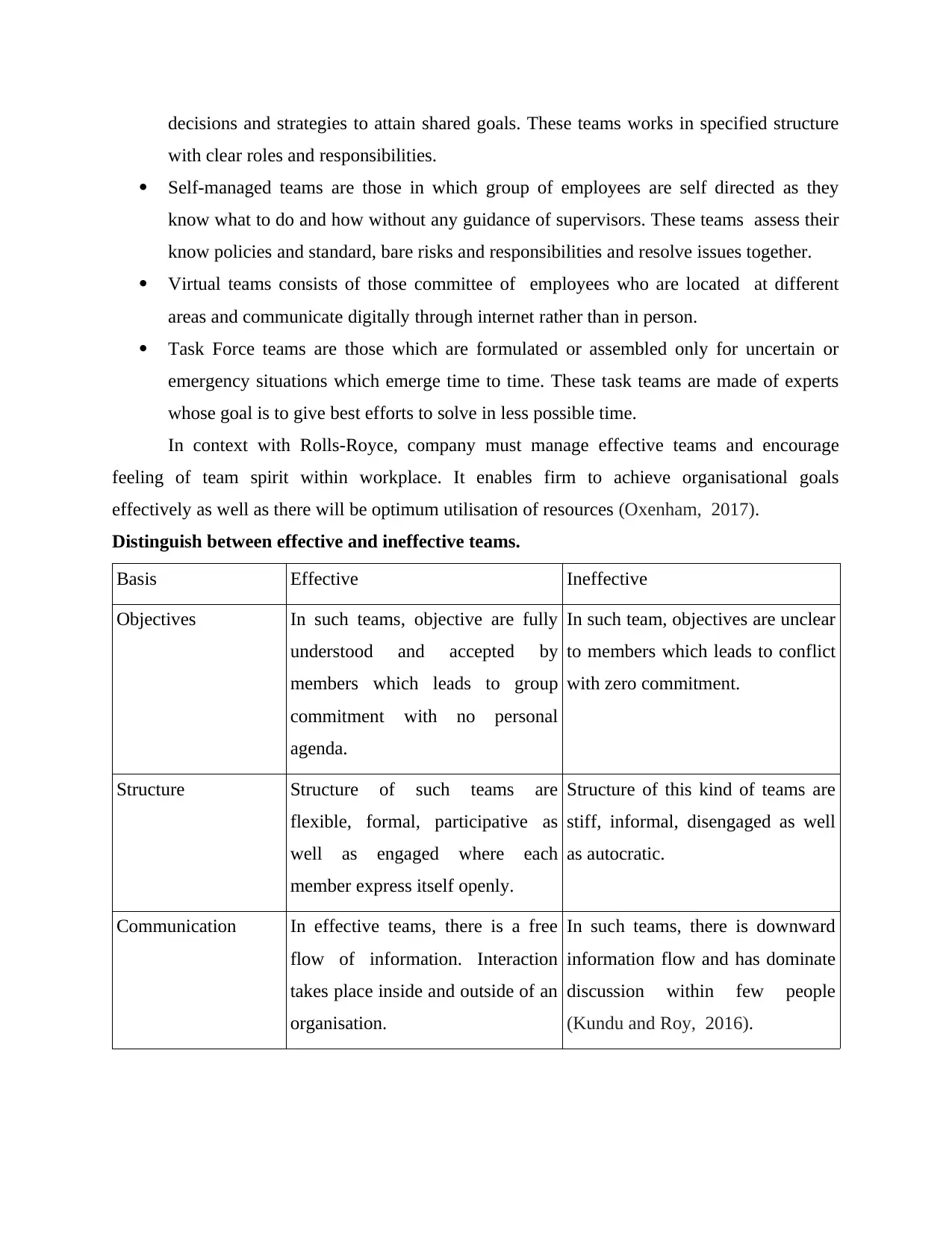
decisions and strategies to attain shared goals. These teams works in specified structure
with clear roles and responsibilities.
Self-managed teams are those in which group of employees are self directed as they
know what to do and how without any guidance of supervisors. These teams assess their
know policies and standard, bare risks and responsibilities and resolve issues together.
Virtual teams consists of those committee of employees who are located at different
areas and communicate digitally through internet rather than in person.
Task Force teams are those which are formulated or assembled only for uncertain or
emergency situations which emerge time to time. These task teams are made of experts
whose goal is to give best efforts to solve in less possible time.
In context with Rolls-Royce, company must manage effective teams and encourage
feeling of team spirit within workplace. It enables firm to achieve organisational goals
effectively as well as there will be optimum utilisation of resources (Oxenham, 2017).
Distinguish between effective and ineffective teams.
Basis Effective Ineffective
Objectives In such teams, objective are fully
understood and accepted by
members which leads to group
commitment with no personal
agenda.
In such team, objectives are unclear
to members which leads to conflict
with zero commitment.
Structure Structure of such teams are
flexible, formal, participative as
well as engaged where each
member express itself openly.
Structure of this kind of teams are
stiff, informal, disengaged as well
as autocratic.
Communication In effective teams, there is a free
flow of information. Interaction
takes place inside and outside of an
organisation.
In such teams, there is downward
information flow and has dominate
discussion within few people
(Kundu and Roy, 2016).
with clear roles and responsibilities.
Self-managed teams are those in which group of employees are self directed as they
know what to do and how without any guidance of supervisors. These teams assess their
know policies and standard, bare risks and responsibilities and resolve issues together.
Virtual teams consists of those committee of employees who are located at different
areas and communicate digitally through internet rather than in person.
Task Force teams are those which are formulated or assembled only for uncertain or
emergency situations which emerge time to time. These task teams are made of experts
whose goal is to give best efforts to solve in less possible time.
In context with Rolls-Royce, company must manage effective teams and encourage
feeling of team spirit within workplace. It enables firm to achieve organisational goals
effectively as well as there will be optimum utilisation of resources (Oxenham, 2017).
Distinguish between effective and ineffective teams.
Basis Effective Ineffective
Objectives In such teams, objective are fully
understood and accepted by
members which leads to group
commitment with no personal
agenda.
In such team, objectives are unclear
to members which leads to conflict
with zero commitment.
Structure Structure of such teams are
flexible, formal, participative as
well as engaged where each
member express itself openly.
Structure of this kind of teams are
stiff, informal, disengaged as well
as autocratic.
Communication In effective teams, there is a free
flow of information. Interaction
takes place inside and outside of an
organisation.
In such teams, there is downward
information flow and has dominate
discussion within few people
(Kundu and Roy, 2016).
⊘ This is a preview!⊘
Do you want full access?
Subscribe today to unlock all pages.

Trusted by 1+ million students worldwide
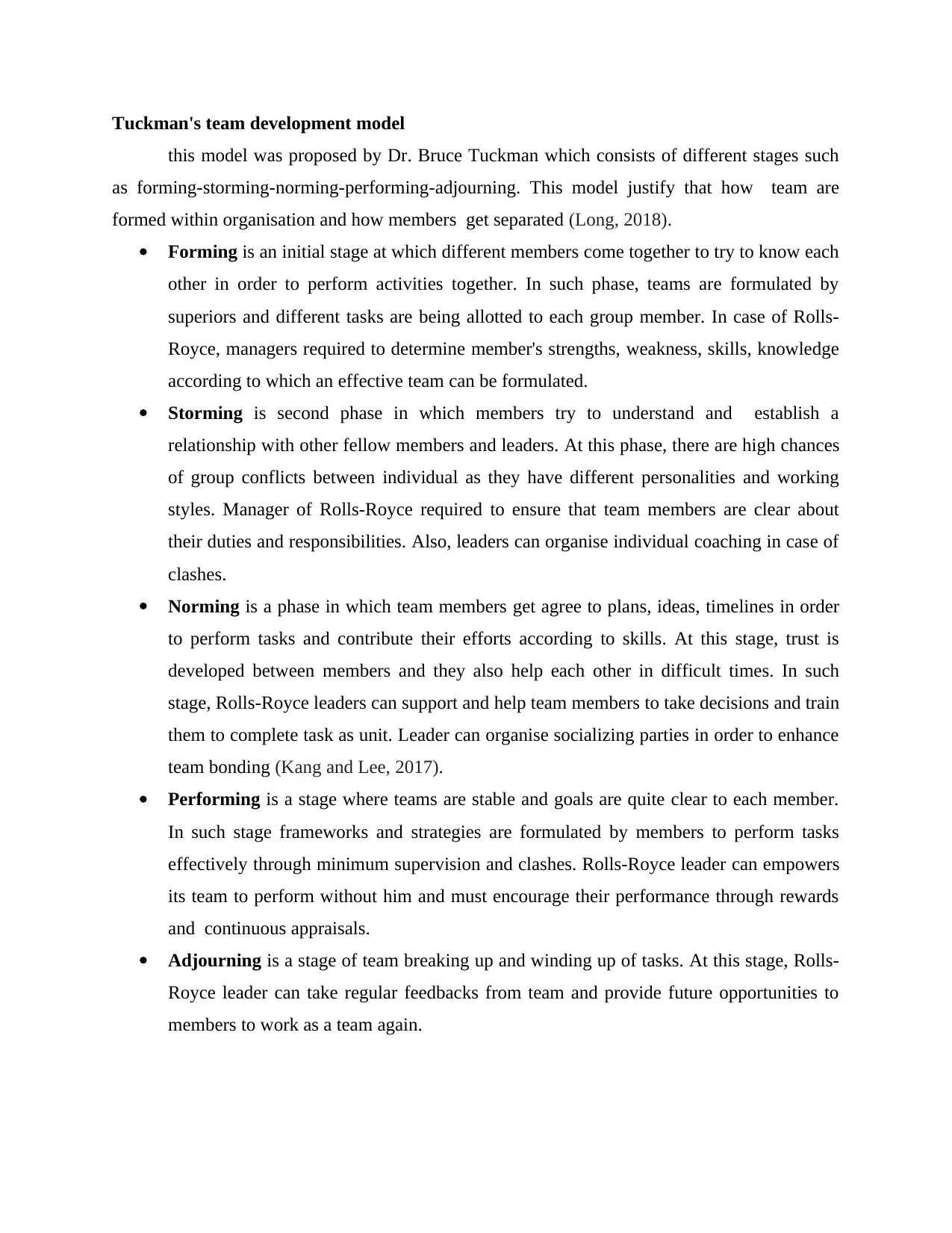
Tuckman's team development model
this model was proposed by Dr. Bruce Tuckman which consists of different stages such
as forming-storming-norming-performing-adjourning. This model justify that how team are
formed within organisation and how members get separated (Long, 2018).
Forming is an initial stage at which different members come together to try to know each
other in order to perform activities together. In such phase, teams are formulated by
superiors and different tasks are being allotted to each group member. In case of Rolls-
Royce, managers required to determine member's strengths, weakness, skills, knowledge
according to which an effective team can be formulated.
Storming is second phase in which members try to understand and establish a
relationship with other fellow members and leaders. At this phase, there are high chances
of group conflicts between individual as they have different personalities and working
styles. Manager of Rolls-Royce required to ensure that team members are clear about
their duties and responsibilities. Also, leaders can organise individual coaching in case of
clashes.
Norming is a phase in which team members get agree to plans, ideas, timelines in order
to perform tasks and contribute their efforts according to skills. At this stage, trust is
developed between members and they also help each other in difficult times. In such
stage, Rolls-Royce leaders can support and help team members to take decisions and train
them to complete task as unit. Leader can organise socializing parties in order to enhance
team bonding (Kang and Lee, 2017).
Performing is a stage where teams are stable and goals are quite clear to each member.
In such stage frameworks and strategies are formulated by members to perform tasks
effectively through minimum supervision and clashes. Rolls-Royce leader can empowers
its team to perform without him and must encourage their performance through rewards
and continuous appraisals.
Adjourning is a stage of team breaking up and winding up of tasks. At this stage, Rolls-
Royce leader can take regular feedbacks from team and provide future opportunities to
members to work as a team again.
this model was proposed by Dr. Bruce Tuckman which consists of different stages such
as forming-storming-norming-performing-adjourning. This model justify that how team are
formed within organisation and how members get separated (Long, 2018).
Forming is an initial stage at which different members come together to try to know each
other in order to perform activities together. In such phase, teams are formulated by
superiors and different tasks are being allotted to each group member. In case of Rolls-
Royce, managers required to determine member's strengths, weakness, skills, knowledge
according to which an effective team can be formulated.
Storming is second phase in which members try to understand and establish a
relationship with other fellow members and leaders. At this phase, there are high chances
of group conflicts between individual as they have different personalities and working
styles. Manager of Rolls-Royce required to ensure that team members are clear about
their duties and responsibilities. Also, leaders can organise individual coaching in case of
clashes.
Norming is a phase in which team members get agree to plans, ideas, timelines in order
to perform tasks and contribute their efforts according to skills. At this stage, trust is
developed between members and they also help each other in difficult times. In such
stage, Rolls-Royce leaders can support and help team members to take decisions and train
them to complete task as unit. Leader can organise socializing parties in order to enhance
team bonding (Kang and Lee, 2017).
Performing is a stage where teams are stable and goals are quite clear to each member.
In such stage frameworks and strategies are formulated by members to perform tasks
effectively through minimum supervision and clashes. Rolls-Royce leader can empowers
its team to perform without him and must encourage their performance through rewards
and continuous appraisals.
Adjourning is a stage of team breaking up and winding up of tasks. At this stage, Rolls-
Royce leader can take regular feedbacks from team and provide future opportunities to
members to work as a team again.
Paraphrase This Document
Need a fresh take? Get an instant paraphrase of this document with our AI Paraphraser
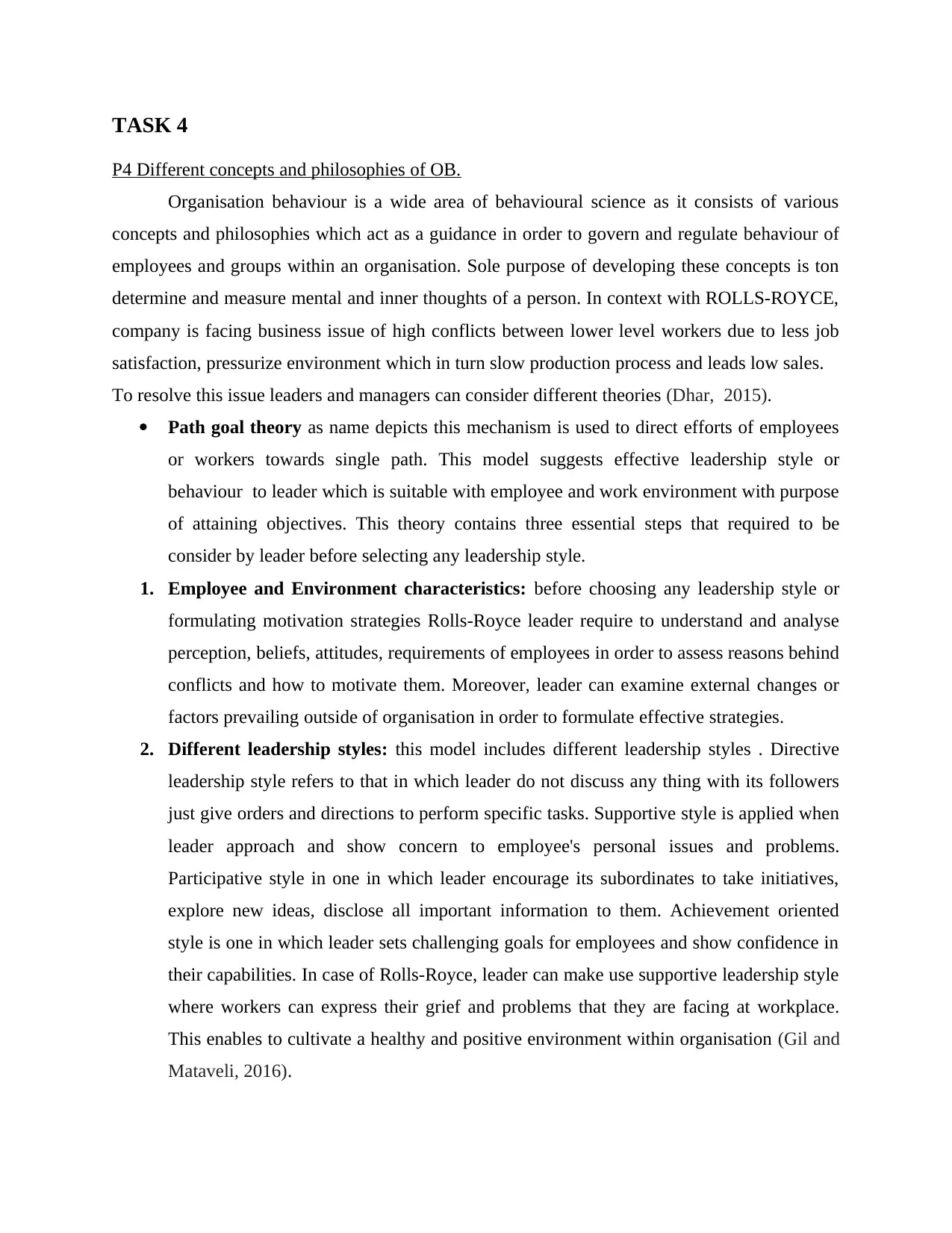
TASK 4
P4 Different concepts and philosophies of OB.
Organisation behaviour is a wide area of behavioural science as it consists of various
concepts and philosophies which act as a guidance in order to govern and regulate behaviour of
employees and groups within an organisation. Sole purpose of developing these concepts is ton
determine and measure mental and inner thoughts of a person. In context with ROLLS-ROYCE,
company is facing business issue of high conflicts between lower level workers due to less job
satisfaction, pressurize environment which in turn slow production process and leads low sales.
To resolve this issue leaders and managers can consider different theories (Dhar, 2015).
Path goal theory as name depicts this mechanism is used to direct efforts of employees
or workers towards single path. This model suggests effective leadership style or
behaviour to leader which is suitable with employee and work environment with purpose
of attaining objectives. This theory contains three essential steps that required to be
consider by leader before selecting any leadership style.
1. Employee and Environment characteristics: before choosing any leadership style or
formulating motivation strategies Rolls-Royce leader require to understand and analyse
perception, beliefs, attitudes, requirements of employees in order to assess reasons behind
conflicts and how to motivate them. Moreover, leader can examine external changes or
factors prevailing outside of organisation in order to formulate effective strategies.
2. Different leadership styles: this model includes different leadership styles . Directive
leadership style refers to that in which leader do not discuss any thing with its followers
just give orders and directions to perform specific tasks. Supportive style is applied when
leader approach and show concern to employee's personal issues and problems.
Participative style in one in which leader encourage its subordinates to take initiatives,
explore new ideas, disclose all important information to them. Achievement oriented
style is one in which leader sets challenging goals for employees and show confidence in
their capabilities. In case of Rolls-Royce, leader can make use supportive leadership style
where workers can express their grief and problems that they are facing at workplace.
This enables to cultivate a healthy and positive environment within organisation (Gil and
Mataveli, 2016).
P4 Different concepts and philosophies of OB.
Organisation behaviour is a wide area of behavioural science as it consists of various
concepts and philosophies which act as a guidance in order to govern and regulate behaviour of
employees and groups within an organisation. Sole purpose of developing these concepts is ton
determine and measure mental and inner thoughts of a person. In context with ROLLS-ROYCE,
company is facing business issue of high conflicts between lower level workers due to less job
satisfaction, pressurize environment which in turn slow production process and leads low sales.
To resolve this issue leaders and managers can consider different theories (Dhar, 2015).
Path goal theory as name depicts this mechanism is used to direct efforts of employees
or workers towards single path. This model suggests effective leadership style or
behaviour to leader which is suitable with employee and work environment with purpose
of attaining objectives. This theory contains three essential steps that required to be
consider by leader before selecting any leadership style.
1. Employee and Environment characteristics: before choosing any leadership style or
formulating motivation strategies Rolls-Royce leader require to understand and analyse
perception, beliefs, attitudes, requirements of employees in order to assess reasons behind
conflicts and how to motivate them. Moreover, leader can examine external changes or
factors prevailing outside of organisation in order to formulate effective strategies.
2. Different leadership styles: this model includes different leadership styles . Directive
leadership style refers to that in which leader do not discuss any thing with its followers
just give orders and directions to perform specific tasks. Supportive style is applied when
leader approach and show concern to employee's personal issues and problems.
Participative style in one in which leader encourage its subordinates to take initiatives,
explore new ideas, disclose all important information to them. Achievement oriented
style is one in which leader sets challenging goals for employees and show confidence in
their capabilities. In case of Rolls-Royce, leader can make use supportive leadership style
where workers can express their grief and problems that they are facing at workplace.
This enables to cultivate a healthy and positive environment within organisation (Gil and
Mataveli, 2016).
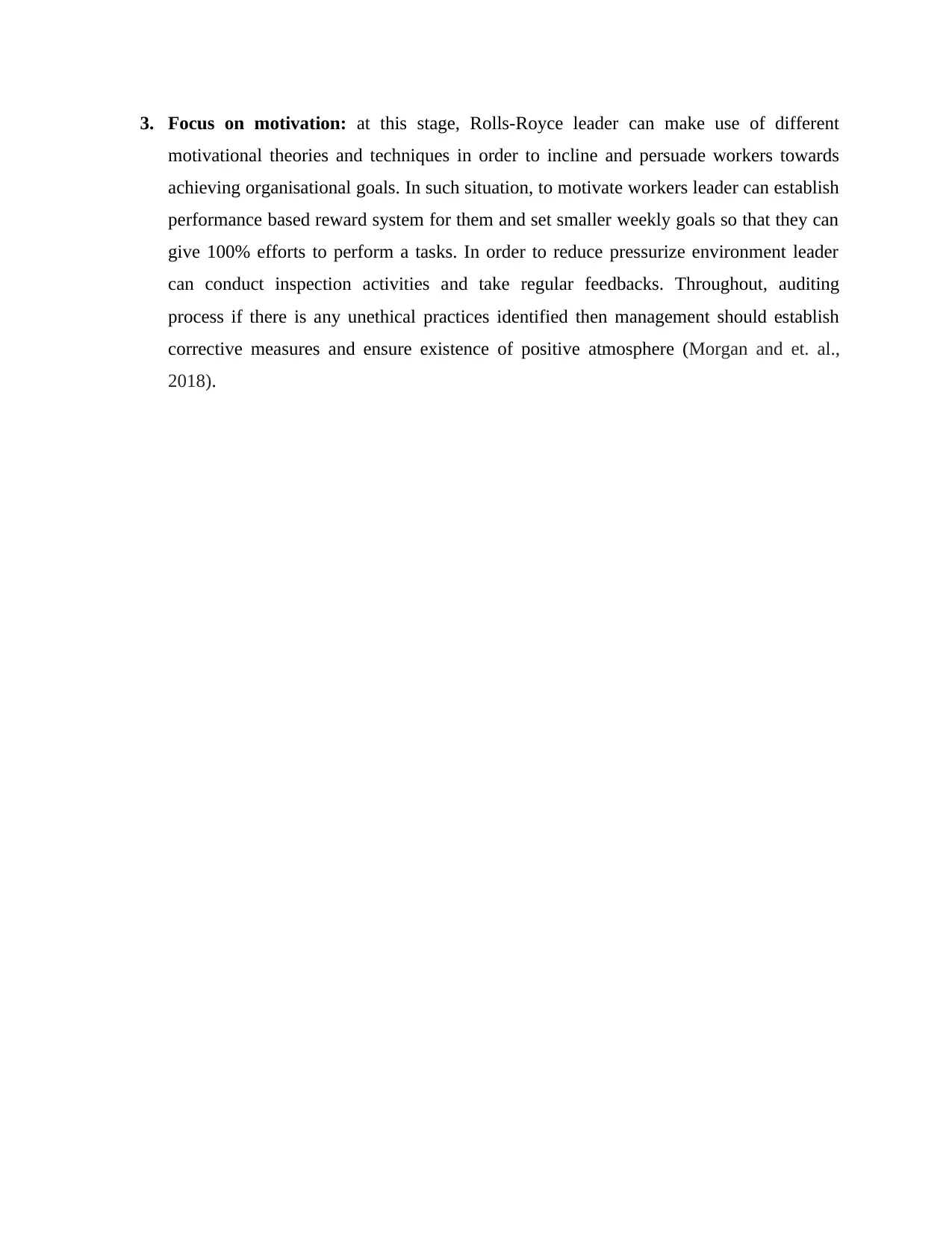
3. Focus on motivation: at this stage, Rolls-Royce leader can make use of different
motivational theories and techniques in order to incline and persuade workers towards
achieving organisational goals. In such situation, to motivate workers leader can establish
performance based reward system for them and set smaller weekly goals so that they can
give 100% efforts to perform a tasks. In order to reduce pressurize environment leader
can conduct inspection activities and take regular feedbacks. Throughout, auditing
process if there is any unethical practices identified then management should establish
corrective measures and ensure existence of positive atmosphere (Morgan and et. al.,
2018).
motivational theories and techniques in order to incline and persuade workers towards
achieving organisational goals. In such situation, to motivate workers leader can establish
performance based reward system for them and set smaller weekly goals so that they can
give 100% efforts to perform a tasks. In order to reduce pressurize environment leader
can conduct inspection activities and take regular feedbacks. Throughout, auditing
process if there is any unethical practices identified then management should establish
corrective measures and ensure existence of positive atmosphere (Morgan and et. al.,
2018).
⊘ This is a preview!⊘
Do you want full access?
Subscribe today to unlock all pages.

Trusted by 1+ million students worldwide
1 out of 14
Related Documents
Your All-in-One AI-Powered Toolkit for Academic Success.
+13062052269
info@desklib.com
Available 24*7 on WhatsApp / Email
![[object Object]](/_next/static/media/star-bottom.7253800d.svg)
Unlock your academic potential
Copyright © 2020–2025 A2Z Services. All Rights Reserved. Developed and managed by ZUCOL.





